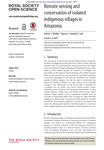Remote sensing and conservation of isolated indigenous villages in Amazonia
| dc.contributor.author | Walker, Robert S. | en_US |
| dc.contributor.author | Hamilton, Marcus J. | en_US |
| dc.contributor.author | Groth, Aaron A. | en_US |
| dc.date.accessioned | 2016-07-18T06:49:09Z | |
| dc.date.available | 2016-07-18T06:49:09Z | |
| dc.date.issued | 2014 | en_US |
| dc.identifier.other | HPU4160440 | en_US |
| dc.identifier.uri | https://lib.hpu.edu.vn/handle/123456789/22283 | en_US |
| dc.description.abstract | The vast forests on the border between Brazil and Peru harbour a number of indigenous groups that have limited contact with the outside world. Accurate estimates of population sizes and village areas are essential to begin assessing the immediate conservation needs of such isolated groups. In contrast to overflights and encounters on the ground, remote sensing with satellite imagery offers a safe, inexpensive, non-invasive and systematic approach to provide demographic and land-use information for isolated peoples. Satellite imagery can also be used to understand the growth of isolated villages over time. | en_US |
| dc.format.extent | 7 p. | en_US |
| dc.format.mimetype | application/pdf | en_US |
| dc.language.iso | en | en_US |
| dc.subject | Ecology | en_US |
| dc.subject | Uncontacted indigenous societies | en_US |
| dc.subject | Land use | en_US |
| dc.subject | Satellite imagery | en_US |
| dc.subject | Amazonia | en_US |
| dc.title | Remote sensing and conservation of isolated indigenous villages in Amazonia | en_US |
| dc.type | Article | en_US |
| dc.size | 913KB | en_US |
| dc.department | Education | en_US |
Files in this item
This item appears in the following Collection(s)
-
Education [806]

